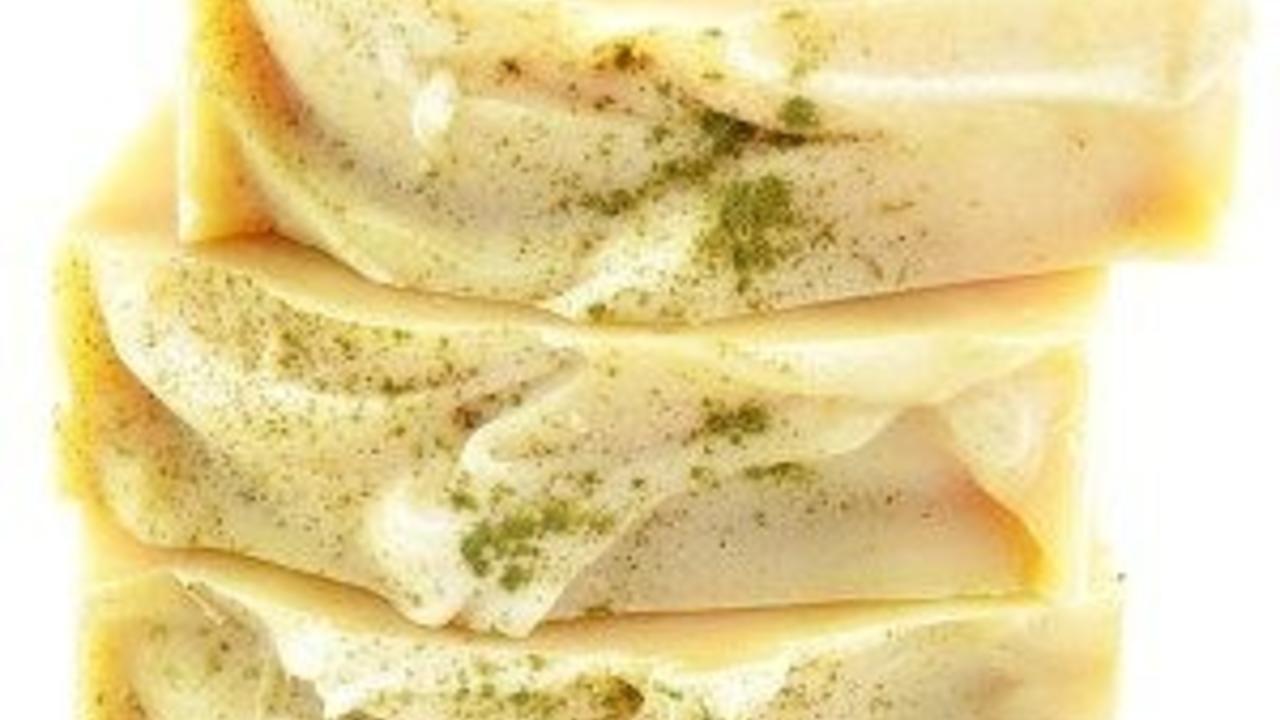How to Make Natural Lemongrass & Coconut Milk Soap

Soapers who make vegan friendly handmade soap often get a little stuck in their soapmaking. Without additives like honey, milk, or silk, it can be a little trying to get a nice creamy addition to a recipe.
Even though animal milks are off the table, plant milks aren't!
Enter Coconut Milk!! Coconut milk makes incredibly creamy and silky vegan soap, and is one of my favorite water replacement additives. Time for a...

Lemongrass and Coconut Milk Soap Recipe
I was a little inspired by thai food in this tutorial, and chose to use lemongrass, ginger, and coconut milk as the main components.
This lemongrass and coconut milk soap recipe is sized for my Bramble Berry 10" Silicone Soap Mold. You can resize it using a lye calculator for whichever mold works for you. As requested, the formula includes percentages for your convenience in doing so!
Let's get started, shall we?
Coconut Milk Soap Formula Used
- 12 ounces Coconut Oil (33.3% of the base oils)
- 10 ounces Rice Bran Oil (27.8% of the base oils)
- 6 ounces Avocado Oil (16.7% of the base oils)
- 6 ounces Shea Butter (16.7% of the base oils)
- 2 ounces Castor Oil (5.6% of the base oils)
- 4.9 ounces Sodium Hydroxide (7% superfat)
- 5 ounces Distilled Water (33% lye solution with the coconut milk added below)
- 5 ounces Coconut Milk
I bought these soapmaking oils from Soaper’s Choice, but you are welcome to buy them from your favorite supplier!
Don’t have one of these oils? Find out how to make an accurate substitution properly, and don’t forget to recalculate your recipe with a lye calculator!
Lemongrass Essential Oil Blend Used
- 34 grams Lemongrass Essential Oil
- 8 grams Fresh Ginger Essential Oil
These essential oils are from Lebermuth, but you can use any fragrances or essential oils your heart desires.
You could also check out our essential oil calculator to find a different blend to suit your fancy!
Natural Colorants Used
These botanical ingredients are from a local grocer, but you can find them at Monterey Bay Spice Company.
PREP WORK: Weigh out all your ingredients. Mix up your lye solution. I add my coconut milk (or other alternative liquids) to my oils directly and use a 50% lye solution with sodium hydroxide and distilled water. This helps prevent any color changes or burning of sugars in alternative liquids.
(Do you have all the gear you need for safe soapmaking? We've listed our picks to protect your health while making soap.)
A note on coconut milk for soap: Not all brands of coconut milk are created equal! Try to snag one that has little to no additional ingredients. It's hard to find one without a thickener (like guar gum), but some also include preservatives, emulsifiers, and more. As a general rule of thumb, the more additives in the coconut milk, the more likely you are to run into acceleration.
Prep your colorants. I add my essential oil blend to my main soaping pot before beginning.
Once you are ready to get to work, bring your soaping oils, coconut milk, and lye solution to an emulsified state (not quite trace).

Measure out the coconut milk
Add the coconut milk to the soaping oils

Add the concentrated lye solution to the oil + coconut milk mix

Stickblend until emulsified
ADD A DASH OF COLOR: I chose dill as a natural colorant for this soap because of it's shape. It's like miniaturized lemongrass (visually and that's all!)
I poured a quarter of my raw soap into a separate container and colored it with wheatgrass powder. Wheatgrass is a lovely muted green. However, it does fade over time to a very muted sage brown.

Add the cut and dried dill to the lemongrass + coconut milk soap

Pour of quarter of the batch into a separate container for coloring

Stir the wheatgrass powder into the separated soap portion
SWIRL IT: I'm using an in-the-mold swirl on this batch (ITMS).
It starts off by pouring half of the main raw soap into the mold. Next, I randomly pour the wheatgrass colored portion in the mold. And then top it off with the remainder of the main batch. I pour from a moderate height to encourage the pour to break through the layers of raw soap in the mold.
As you can tell by the photos, the soap was thickening rapidly due to the coconut milk. (The ginger essential oil also contributes to this!) This is why it's important to initially mix to an emulsified state rather than trace. And any further mixing is done with a spatula.

Pour half the main pot of soap into the mold

Pour wheatgrass colored soap into the mold

Top off the lemongrass + coconut milk soap with the remainder of the raw soap
THE FINISH LINE: Once it's all in the mold, it's time to pretty it up. I textured the soap tops by dragging the corner of my spatula from the outside of the mold towards the middle on both sides. I finished it up by sprinkling a little wheatgrass powder over the top.
Once you are all done, insulate your soap. Unmold after 12 to 24 hours. Cut and cure!

Texture the top of the lemongrass + coconut milk soap before putting it to bed

Cured Lemongrass + Coconut Milk Soap
The lemongrass and coconut milk soap recipe featured in this tutorial is a Modern Soapmaking original. It is palm-free & vegan friendly. It uses a 7% superfat and a 33% lye solution strength. Feel free to adjust as necessary!
Want to snag weekly advice on building a successful soap biz directly in your inbox?
Of course you do! Sign up for our newsletter below for more tips and tricks to make bank in your biz.

